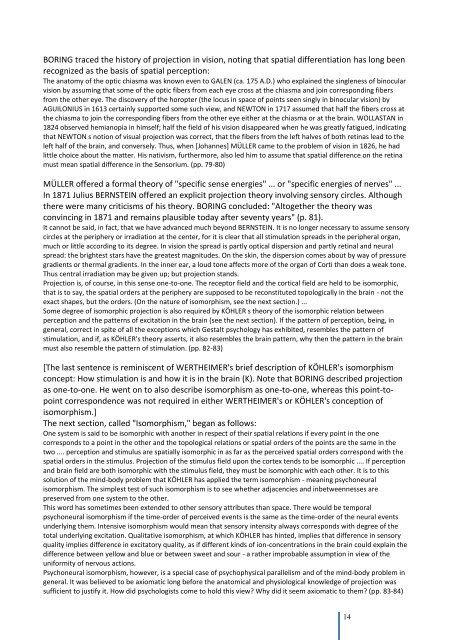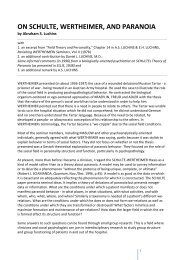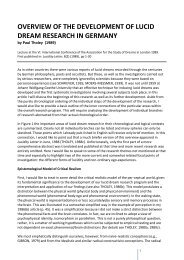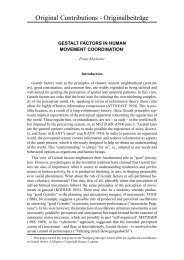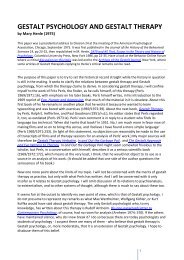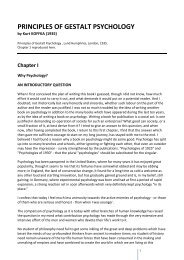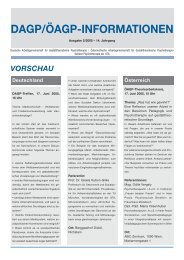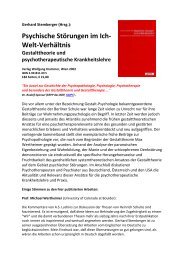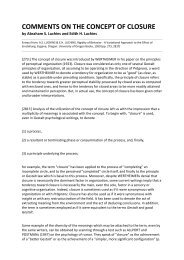pdf-Download - Society for Gestalt Theory and its Applications (GTA)
pdf-Download - Society for Gestalt Theory and its Applications (GTA)
pdf-Download - Society for Gestalt Theory and its Applications (GTA)
Create successful ePaper yourself
Turn your PDF publications into a flip-book with our unique Google optimized e-Paper software.
BORING traced the history of projection in vision, noting that spatial differentiation has long beenrecognized as the basis of spatial perception:The anatomy of the optic chiasma was known even to GALEN (ca. 175 A.D.) who explained the singleness of binocularvision by assuming that some of the optic fibers from each eye cross at the chiasma <strong>and</strong> join corresponding fibersfrom the other eye. The discovery of the horopter (the locus in space of points seen singly in binocular vision) byAGUILONIUS in 1613 certainly supported some such view, <strong>and</strong> NEWTON in 1717 assumed that half the fibers cross atthe chiasma to join the corresponding fibers from the other eye either at the chiasma or at the brain. WOLLASTAN in1824 observed hemianopia in himself; half the field of his vision disappeared when he was greatly fatigued, indicatingthat NEWTON s notion of visual projection was correct, that the fibers from the left halves of both retinas lead to theleft half of the brain, <strong>and</strong> conversely. Thus, when [Johannes] MÜLLER came to the problem of vision in 1826, he hadlittle choice about the matter. His nativism, furthermore, also led him to assume that spatial difference on the retinamust mean spatial difference in the Sensorium. (pp. 79-80)MÜLLER offered a <strong>for</strong>mal theory of "specific sense energies" ... or "specific energies of nerves" ...In 1871 Julius BERNSTEIN offered an explicit projection theory involving sensory circles. Althoughthere were many criticisms of his theory. BORING concluded: "Altogether the theory wasconvincing in 1871 <strong>and</strong> remains plausible today after seventy years" (p. 81).It cannot be said, in fact, that we have advanced much beyond BERNSTEIN. It is no longer necessary to assume sensorycircles at the periphery or irradiation at the center, <strong>for</strong> it is clear that all stimulation spreads in the peripheral organ,much or little according to <strong>its</strong> degree. In vision the spread is partly optical dispersion <strong>and</strong> partly retinal <strong>and</strong> neuralspread: the brightest stars have the greatest magnitudes. On the skin, the dispersion comes about by way of pressuregradients or thermal gradients. In the inner ear, a loud tone affects more of the organ of Corti than does a weak tone.Thus central irradiation may be given up; but projection st<strong>and</strong>s.Projection is, of course, in this sense one-to-one. The receptor field <strong>and</strong> the cortical field are held to be isomorphic,that is to say, the spatial orders at the periphery are supposed to be reconstituted topologically in the brain - not theexact shapes, but the orders. (On the nature of isomorphism, see the next section.) ...Some degree of isomorphic projection is also required by KÖHLER s theory of the isomorphic relation betweenperception <strong>and</strong> the patterns of excitation in the brain (see the next section). If the pattern of perception, being, ingeneral, correct in spite of all the exceptions which <strong>Gestalt</strong> psychology has exhibited, resembles the pattern ofstimulation, <strong>and</strong> if, as KÖHLER's theory asserts, it also resembles the brain pattern, why then the pattern in the brainmust also resemble the pattern of stimulation. (pp. 82-83)[The last sentence is reminiscent of WERTHEIMER's brief description of KÖHLER's isomorphismconcept: How stimulation is <strong>and</strong> how it is in the brain (K). Note that BORING described projectionas one-to-one. He went on to also describe isomorphism as one-to-one, whereas this point-topointcorrespondence was not required in either WERTHEIMER's or KÖHLER's conception ofisomorphism.]The next section, called "Isomorphism," began as follows:One system is said to be isomorphic with another in respect of their spatial relations if every point in the onecorresponds to a point in the other <strong>and</strong> the topological relations or spatial orders of the points are the same in thetwo .... perception <strong>and</strong> stimulus are spatially isomorphic in as far as the perceived spatial orders correspond with thespatial orders in the stimulus. Projection of the stimulus field upon the cortex tends to be isomorphic .... If perception<strong>and</strong> brain field are both isomorphic with the stimulus field, they must be isomorphic with each other. It is to thissolution of the mind-body problem that KÖHLER has applied the term isomorphism - meaning psychoneuralisomorphism. The simplest test of such isomorphism is to see whether adjacencies <strong>and</strong> inbetweennesses arepreserved from one system to the other.This word has sometimes been extended to other sensory attributes than space. There would be temporalpsychoneural isomorphism if the time-order of perceived events is the same as the time-order of the neural eventsunderlying them. Intensive isomorphism would mean that sensory intensity always corresponds with degree of thetotal underlying excitation. Qualitative isomorphism, at which KÖHLER has hinted, implies that difference in sensoryquality implies difference in excitatory quality, as if different kinds of ion-concentrations in the brain could explain thedifference between yellow <strong>and</strong> blue or between sweet <strong>and</strong> sour - a rather improbable assumption in view of theuni<strong>for</strong>mity of nervous actions.Psychoneural isomorphism, however, is a special case of psychophysical parallelism <strong>and</strong> of the mind-body problem ingeneral. It was believed to be axiomatic long be<strong>for</strong>e the anatomical <strong>and</strong> physiological knowledge of projection wassufficient to justify it. How did psychologists come to hold this view? Why did it seem axiomatic to them? (pp. 83-84)14


